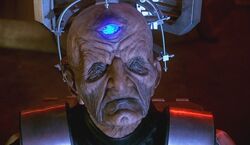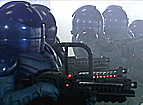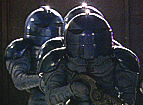
Saturday 29 November 2008
Wednesday 23 July 2008
Rose Tyler.

Name: Rose Marion Tyler
Species: Human
Age: 19 (when she met the Doctor).
Homeplanet: Earth (London, 48 Bucknall House, the Powell Estate, SE15 7GO).
Vehicle: None
Facts: Rose Tyler lives with her mum, Jakcie Tyler, and near her boyfriend, Mickey Smith, who left to stay in the parallel world when the crew fought the Cybermen there. While there, Rose also met her parallel dad, Pete Tyler, who had died in 1987, the year after Rose was born. She used to work at Henriks Department Store, until she began travelling with the Doctor.
Appearances: First appearance was in 2005 in Series 1's first episode "Rose"
Followed on up to the last episode of Series 2, "Doomsday."
Donna Noble
 Donna Noble was a temp from Chiswick before she met the doctor. She first met the Doctor at Christmas in 2006 when human particles transported her into the TARDIS. She said no to travelling in the TARDIS. Then in 2008 she met the Doctor again this time at Adipose Industries. She then said yes to travel in the TARDIS. She battled monsters like, the Ood, the Sontarans, the Hath, the Vespiform and the Daleks. In Turn Left she saved the whole of creation with the help of Rose Tyler. In the series finale she touched the doctor's hand in the jar and she became half doctor, half donna. But in the end the Doctor had to wipe her mind and that side of Donna is Dead. She's still alive but has forgotten of the Doctor.
Donna Noble was a temp from Chiswick before she met the doctor. She first met the Doctor at Christmas in 2006 when human particles transported her into the TARDIS. She said no to travelling in the TARDIS. Then in 2008 she met the Doctor again this time at Adipose Industries. She then said yes to travel in the TARDIS. She battled monsters like, the Ood, the Sontarans, the Hath, the Vespiform and the Daleks. In Turn Left she saved the whole of creation with the help of Rose Tyler. In the series finale she touched the doctor's hand in the jar and she became half doctor, half donna. But in the end the Doctor had to wipe her mind and that side of Donna is Dead. She's still alive but has forgotten of the Doctor.Daleks
 Affiliated with - Dalek Empire
Affiliated with - Dalek Empire Homeworld - Skaro
The Daleks are a fictional extraterrestrial race of mutants from Doctor Who. A Dalek is a grotesque mutated organism integrated with a tank-like mechanical casing made of 'polycarbide'. The resulting creatures are a pitiless race bent on universal conquest and domination. They are also, collectively, the greatest alien adversaries of the Time Lord known as the Doctor. Their most famous catchphrase is "EX-TER-MI-NATE!", with each syllable individually screeched in a frantic electronic voice.
The Daleks were created by writer Terry Nation and BBC designer Raymond Cusick and were introduced in December 1963 in the second Doctor Who serial. They became an immediate hit with viewers, featuring in many subsequent serials and two 1960s motion pictures. They have become synonymous with Doctor Who, and their behaviour and catchphrases are part of British popular culture. "Hiding behind the sofa whenever the Daleks appear".
It is also a trademark, having first been registered by the BBC in 1964 to protect its lucrative range of Dalek merchandise.
Externally, Daleks resemble human-sized salt or pepper shakers around five to six feet (152 to 183 cm) tall, with a single mechanical eyestalk mounted on a rotating dome, a gunstalk containing a projected energy weapon (or "death ray"), and a telescoping robot arm. Usually, the arm is fitted with a device for manipulation that resembles a sink plunger, but Daleks have been shown with arms that end in a tray, a mechanical claw, or other specialised equipment like flamethrowers and blowtorches. Daleks have used their plunger-like manipulator arms to interface with technology, to kill a man by crushing his skull and to extract the brainwaves from a man's head, killing him in the process. Dalek casings are made of a bonded polycarbide material that was dubbed 'dalekanium' by a human in The Dalek Invasion of Earth.
The lower half of a Dalek's shell is covered with many hemispherical protrusions or "Dalek bumps". These are described as "sense globes" or sensors in The Doctor Who Technical Manual by Mark Harris (which is of uncertain). However, in the 2005 series episode Dalek, they are part of a self-destruct system. The casings are vulnerable to "bastic"-headed bullets, and when breached tend to explode spectacularly.
The creatures inside the "travel machines" are depicted as soft and repulsive in appearance, and still vicious even without their mechanical armour. The first glimpse of the mutant in The Daleks was a claw peeking out from under a coat after it had been removed from the machine. The actual appearance of the mutant has varied, but in most cases it is an octopus-like multi-tentacled creature. The Doctor described the Daleks as "little green blobs in bonded polycarbide armour" in Remembrance of the Daleks, where a Dalek mutant was seen to have a bionically augmented claw. In Resurrection of the Daleks a Dalek creature, separated from its casing, attacks and severely injures a human soldier.
However, as the creature inside is rarely seen on screen, the misconception exists that Daleks are wholly mechanical robots. (The series itself has even made this mistake on occasion). The interdependence of biological and mechanical components makes the Daleks a type of cyborg. The Ninth Doctor, in Dalek, described the Dalek as a genius: it could run through an electronic lock's billion combinations in seconds and download all of the information on the internet into its memory, showing the union of the biological and mechanical components.
The voice of a Dalek is electronic; the Dalek creature is apparently unable to make much more than squeaking sounds when out of its casing. Once the mutant is removed, the casing itself can be entered and operated by humanoids, as seen in The Daleks, The Space Museum and Planet of the Daleks. In The Daleks, Ian Chesterton disguises himself by hiding in a Dalek shell, which alters his voice to sound like that of a Dalek.
Cybermen

CYBUS CYBERMEN
15. Cybermen
The Cybermen are a race of metal men who are amongst the most reappearing enemies of the Doctor in Doctor Who. Cybermen were originally a wholly organic species of humanoids originating on Earth's twin planet Mondas that began to implant more and more artificial parts into their bodies. This led to the race becoming coldly logical and calculating, with emotions usually only shown when naked aggression was called for.
A parallel universe version of the Cybermen appeared in the 2006 series' two-part story, Rise of the Cybermen and The Age of Steel. These Cybermen also appeared in the two-part 2006 season finale, Army of Ghosts and Doomsday. This then carried through to the spin-off Torchwood in the episode Cyberwoman.
While the Doctor's other old enemies the Daleks were on the whole unchanged during the original series' twenty-six season run, the Cybermen were seen to change with almost every encounter. The Cybermen are humanoid, but have been cybernetically augmented to the point where they have few remaining organic parts. In their first appearance in the series, the only portions of their bodies that still seemed human were their hands, but by their next appearance in The Moonbase (1967), their bodies were entirely covered up in their metallic suits. As they are relatively few in number, the Cybermen tend towards covert activity, scheming from hiding and using human pawns or robots to act in their place until they need to appear. They also seek to increase their numbers by converting others into Cybermen (a process known as "cyber-conversion").
It is presumed (and often implied) that beneath their suits still exist organic components and that they are not true robots: in The Tenth Planet, a Cyberman tells a group of humans that "our brains are just like yours", although by the time of Attack of the Cybermen this seemed to have been replaced with electronics. In Earthshock (1982), the actors' chins were vaguely visible through a clear perspex area on the helmet to suggest some kind of organic matter. In The Tomb of the Cybermen (1967), veins were visible through the domed head of the Cyberman Controller and similarly, in Attack of the Cybermen (1985) and The Age of Steel, the Cyber-Controller's brain is visible through the dome. However, in Revenge of the Cybermen (1975), the Doctor says they are "total machine creatures".
The audio play Real Time implies that the converted victim's face remains beneath the Cyberman faceplate, although the audio plays, like all non-televised spin-off media, are of uncertain canonicity with regards to the television series. The Virgin New Adventures novel Iceberg by David Banks states that some Cybermen experience rare flashes of emotional memory from the time before they were converted, which are then usually suppressed. The parallel Earth Cybermen in the 2006 series are usually constructed from human brains bonded to a Cyberman exoskeletal shell with an artificially grown nervous system threaded throughout (The Age of Steel), although direct grafting of cyber-components is another method of conversion (Cyberwoman).
Although the Cybermen often claim that they have done away with human emotion, they have exhibited emotions ranging from anger to smug satisfaction in their confrontations with the Doctor (although this is only clearly present during their appearances in the 1980s). Some Cybermen in the early stories were even given individual names such as "Krang". Some parallel Earth Cybermen did retain some memories of their pre-conversion lives, although their emotional response varied. In Cyberwoman, the partial conversion led to a degree of insanity in Lisa Hallett, which was retained even after she transferred her brain into a human body. In Doomsday, Yvonne Hartman is able to retain at least some elements of her personality in order to prevent the advance of a group of other Cybermen, and is last seen weeping what appears to be either an oil-like substance or blood. In the same episode, the Cyber-Leader expresses clear frustration at the humans refusing to surrender, although in a later scene he criticizes the Doctor for showing emotion.
The Virgin Missing Adventures novel Killing Ground by Steve Lyons suggests that some Cybermen imitate emotions to intimidate and unnerve their victims. The Big Finish Productions audio play Spare Parts (set on Mondas in the early days of cyber-conversion) suggests that the Cybermen deliberately remove their emotions as part of the conversion process to stifle the physical and emotional trauma of becoming a Cyberman. The conversion process in the parallel Earth is termed "upgrading".
This motive behind the removal of emotions is made more explicit in The Age of Steel where it is done by means of an emotional inhibitor. In that episode, the deactivation of their emotional inhibitors drives the converted Cybermen insane when they realise what they have become, killing them.
Cybermen have a number of major weaknesses, of which the most notable is the element gold. Initially, it was explained that, due to its non-corrodible nature, gold essentially chokes their respiratory systems. For example, the glittergun, a weapon used during the Cyber-Wars in the future, fired gold dust at its targets. However, in later serials, gold appeared to affect them rather like silver affects werewolves, with gold coins or gold-tipped bullets fired at them having the same effect. Cybermen are also rather efficiently killed when shot with their own guns. Other weaknesses from early stories include solvents, gravity based technology, and excessive levels of radiation.
Their weakness to gold has not been mentioned during the 2006 series, although the Cybus Industries tie-in site makes reference to earlier prototypes having an "allergy" to gold, stating that this was eliminated after further improvements of the Cyberman body. In The Age of Steel, however, an EMP grenade is shown to disable a Cyberman and shut down its emotional inhibitor.
Some Cybermen are given titles, being credited as "Cyber Leader" (or variants thereof), "Cyber Lieutenant", "Cyber Scout" or the "Cyber Controller". The Cyber Controller in particular has appeared in multiple forms, both humanoid and as an immobile computer, and has also been referred to as the "Cyber Planner" or "Cyber Director", although these may not be the same being. The Controller seen (and destroyed) in various serials also may or may not be the same consciousness in different bodies, as it appears to recognize and remember the Doctor from previous encounters. In Iceberg, the first Cyber Controller is created by implanting a Cyber Director into the skull of a recently converted Cyberman.
The Cyber-Controller in The Age of Steel used the brain of John Lumic, the creator of the Cybermen in that parallel reality. In Doomsday, a Cyber-Leader appears, and when he is destroyed, mention is made of downloading his data files into another Cyberman unit, which is then upgraded to Cyber-Leader.
In the Rise of the Cybermen/The Age of Steel two-part story, the Tenth Doctor visited a parallel universe where the Cybermen were being created on modern-day Earth. These alternate Cybermen were created as an "upgrade" to humanity and the ultimate move into cyberspace, allowing the brain to survive in an ageless steel body. These Cybermen also referred to themselves as "Human.2" and "deleted" all those deemed incompatible with the upgrade. They could fatally electrocute humans with a touch.
These Cybermen were created by John Lumic, a terminally ill and insane genius whose company, Cybus Industries, had advanced humanity considerably. To find a way to survive, he perfected a method to sustain the human brain indefinitely in a cradle of chemicals, bonding the synaptic impulses to a metal exoskeleton. The Cybermen "handle bars" were part of a high-tech communications device called an EarPod. Also created by Lumic, the EarPods were used extensively in the place of MP3 players and mobile phones, allowing information to be directly downloaded into people's heads.
Lumic began to abduct homeless people and convert them into Cybermen, and assassinated the President of Great Britain after the President rejected his plans. Using the EarPods, Lumic took mental control of London, marching thousands to be cyber-converted. He was betrayed by an old friend who damaged his wheelchair's life-support systems. He had told the Cybermen that he would upgrade 'only with my last breath' and since that moment was at hand he was involuntarily upgraded into the Cyber-Controller, a superior model of Cyberman. However, the Tenth Doctor and his companions, having accidentally landed on the parallel Earth, managed to foil his plans. They freed London from mental control and disabled the Cybermen's emotional inhibitors, causing them to go insane and in some cases explode. Lumic himself fell to his apparent death into the burning remains of his factory. A human resistance group, the Preachers, then set about to clean up the remainder of Lumic's factories around the world.
These Cybermen reappeared in the 2006 season finale Army of Ghosts and Doomsday. It is to be noted that these Cybermen also use energy weapons built into their right arms. Having infiltrated that world's version of the Torchwood Institute and discovering a breach between universes caused by the passage of an interdimensional void ship, the Cybermen used it to invade the Doctor's universe. However, the void ship's users, the Daleks also revealed themselves, leading to all-out war across the planet between the two sides with mankind caught in the crossfire. Eventually, the Doctor re-opened the breach, causing the Cybermen and Daleks (who had been saturated with background radiation from the Void) to be sucked back into it. The breach then sealed itself, leaving the Cybermen and Daleks seemingly trapped in the Void forever.
These Cyberman are usually described as 'Cybus Cybermen' as opposed to the 'Mondas Cybermen.'
In Cyberwoman it was revealed that at the height of the "Battle of Canary Wharf", due to their desperate need for reinforcements against the Daleks, the Cybermen had begun to directly convert whole bodies rather than transplant their brains into Cyberman shells. One of their victims, a woman called Lisa Hallett, was only partially converted when the power was shut off and was rescued by her boyfriend, Ianto Jones.
Jones took her to Torchwood Three in Cardiff along with a cyber-conversion unit which he made into a life support system for her under her directions. He tried to find a cure for her condition, calling on cybernetics expert Dr Tanizaki. Unfortunately Hallett's Cyberman personality asserted itself, leading to her killing Tanizaki and trying to take over Torchwood Three as a staging area for a new Cyberman army. She eventually transplanted her own brain into the body of a pizza delivery girl whom she let into the base, and was shot to death by the other members of the Torchwood team.
Davros
Early life
Davros was born during the Thousand Year War between Thals and Kaleds on the planet Skaro. It was a time when mercy and nobility were all but non-existent and life was harsh and grim. The use of atomic weapons and other agents of mutation had started to produce mutants known as mutos, however Davros himself was originally physically healthy and un-deformed. (DW: Genesis of the Daleks)
As a child Davros claimed only his mother believed in him. Others feared him and his determination. His father wanted him to become a soldier like his elder generations. Davros was determined to become a scientist. (BFD: Innocence)
Davros had a sister called Yarvell. Davros disagreed with her ideas of a compromise with the Thals. Davros was forced into the military where he was put in charge of developing new weapons. After his mother killed his father, sister and aunt, Davros no longer had anyone that he could impress. In honour of Yavel's death he and his mother commissioned a statue to be made to house her ashes. (BFD: Purity)
Davros began experimenting with organisms and teaching them to speak. In particular the word 'Davros.' For his first experiment he used a Thal brain instead of a Kaled one. (BFA: Guilt)
Davros was grievously wounded by an attack and afterwards he needed a mobile life support system just to stay alive, let alone to move. (DW: Remembrance of the Daleks) 30 seconds without his life support would have killed him. The life support system was controlled by a switch conveniently placed on his panel of buttons on his life support system. (DW: Genesis of the Daleks)
Creation of the Daleks
- "Today, the Kaled race is ended, consumed in a fire of war. But, from its ashes will rise a new race. The supreme creature. The ultimate conqueror of the universe. The Dalek!"
- ―Davros.[src]
With his equally ruthless aide Nyder, Davros ascended to a high rank in the Kaled Scientific Elite and presided over the creation of the Daleks. (DW: Genesis of the Daleks)
- For more see main article.
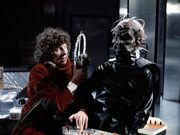
Davros was originally exterminated by his Daleks. However, intervention by the Time Lords began a chain of events, started by the The Doctor being sent to Skaro during this time period, where Davros first demonstrated the Daleks to the Kaled Scientific Elite. The Doctor and Davros first met at this time. Davros learned of the Doctor's mission and imprisoned him. He used a lie detector to force the Doctor to reveal the details of the Daleks' future defeats, so that he could learn from them and so that his creation, the Daleks, could avoid them. (The Doctor later had this record destroyed.) (DW: Genesis of the Daleks)
- The official BBC Doctor Who website specifies that there are two Dalek histories, the second created by the Time Lord intervention in Dalek development. In the original timeline, Davros was killed, but he survived in the new version of events.
"Death" and revival
- "I created you. I am the master. Not you, I, I, I!"
- ―Davros[src]
The Daleks eventually turned on Nyder and exterminated him. Later, they apparently exterminated Davros himself (DW: Genesis of the Daleks), but he had in fact activated a force field around his travel unit and survived in a form of suspended animation while his life support worked to regenerate him. After an unknown period of time had passed, Davros was sought both by the Daleks, now a major galactic power, and by the Doctor. The Daleks sought to revive Davros so that he might offer them a way out of their impasse in their war with the Movellans. Davros was found in the underground remains of the crumbled scientific elite bunker, and was revived. Davros opted to help the Daleks in their war against the Movellans. He devised a plan to destroy a Movellan ship but after this failed he was captured by the Doctor and escaped Dalek slaves and imprisoned in a block of ice. (DW: Destiny of the Daleks)
Leader of the Imperial Daleks faction
- "I have waited a long time for this. Once the Doctor is exterminated, I shall build a new race of Daleks. They will be even more deadly and I, Davros, shall be their leader! This time we shall triumph. My Daleks shall once more become the supreme beings!"
- ―Davros.[src]
The Humans decreed an indefinite sentence of suspended animation, during which time Davros retained full consciousness. After 90 years, the Daleks, led by the Dalek Supreme, liberated Davros from his prison ship in space, and revived him once more. They believed that he might help them to find a cure for the virus with which the Movellans defeated them: a virus that attacks only Dalek tissue. Under the pretense of discovering the cure, Davros began experimenting on Daleks to bring them under his control. The Doctor, now in a new incarnation, attempted to kill Davros during this time, though he ultimately lacked the resolve to do so directly. His treachery discovered by the Dalek Supreme, Davros released the Movellan virus onto the prison ship, effectively killing all the Daleks on board. The virus then began affecting Davros, who promptly fled in an escape pod before Stien caused the station -- and the prison ship -- to explode. (DW: Resurrection of the Daleks)
Davros at this point almost took his own life. He met the Doctor and tormented him as he would not kill him. (BFA: Davros)
Davros, however, survived, and set himself up as "The Great Healer" on the planet Necros and lured the Doctor there. Using the bodies of the dead at Tranquil Repose, Davros created a new race of Daleks with white and gold livery, who would later be called "Imperial Daleks". The new faction was totally loyal to him. The Supreme Dalek's forces arrived on Necros -- having been brought there by Tranquil Repose's disgruntled staff -- and captured him to put him on trial. (DW: Revelation of the Daleks)
- For more background on and an account of the war that followed between Dalek factions, see Imperial-Renegade Dalek Civil War.
By the time of his attempt to recover the Hand of Omega from 1963 Earth he called himself the Dalek Emperor (of the Imperial Daleks only). Apparently, he had lost most of his organic body, and was completely encased within an Imperial Dalek-like shell, though his head and upper body still appeared to be at least partially Kaled. (DW: Remembrance of the Daleks) Apparently killed by a supernova started by the Hand of Omega, he survived by escaping in an escape pod (again) and lived to confront the Doctor in his eighth incarnation.
Davros found himself teetering on the edge of sanity when he encountered the Eighth Doctor on Earth, which he had taken over with a virus. At this time, Davros's Dalek personality was very nearly dominant. At the end of the story, Davros becomes the Emperor of the Daleks, his mind fully turned into Dalek. Presumably he may have been encased in the Emperor Dalek casing in "The Evil Of The Daleks" and the explosions resulting from the Dalek Civil War restored his "Davros" personality, however this is only speculation. Davros possibly managed to shift his consciousness into a clone body which enabled him to participate in the Last Great Time War. (BFA: Terror Firma)
After this, Davros went on to be the commander of the Daleks in the Time War, only to supposedly die during the first year of the conflict (despite the Doctor's efforts to save him) at the Gate of Elysium, when his command ship flew into the jaws of the Nightmare Child. However, Dalek Caan broke the War's time lock and saved him from death. Davros then rebuilt the Dalek race by using a large number of his own cells, turning each one into a new Dalek, leaving his internal organs and skeleton exposed (under his jacket). Davros called these Daleks his "children". (DW: The Stolen Earth)
Return
- "Welcome... to my new empire, Doctor."
- ―Davros.[src]
After Davros was rescued by Dalek Caan and had finished creating his new army of Daleks, he used his Dalek Flying Saucer known as the Crucible to travel the universe and "steal" planets. These planets were then put around the Crucible. Earth was the final planet to be taken by Davros and his New Daleks. They took the planets to the Medusa Cascade where he and his Daleks awaited the arival of the Doctor in a pocket of time 1 second out of sync with the rest of the universe. Davros used advanced technology to hack into the wavelengths of the Subwave Network and talk to the Doctor, explaining to his nemesis how he had survived. (DW: The Stolen Earth)
It quickly became apparent that Davros had once again become a slave to the Daleks rule who placed him under guard within the Vault on the Crucible as part of a deal he made with the Supreme One. This arrangement required Davros to build a Reality bomb powered by the Crucible and the 27 planets in the Medusa Cascade which would destroy all of existence leaving the Daleks the sole inhabitants of the universe. However, his plan failed due to the intervention of the Doctor and Donna Noble who destroyed the Dalek race once more leaving Davros on a burning Crucible. Before leaving in the TARDIS, the Doctor offered to save Davros but the creator of the Daleks refused stating that he named the Doctor the destroyer of worlds, after which he was engulfed in flames. (DW: Journey's End)
Creations
- "Supreme Dalek? Ha! That is a title I shall dispute most vigorously, I created the Daleks. It is I who shall control their destiny, I am the Supreme Commander!"
- ―Davros.[src]
Most notable of Davros' creations is the Mark III travel machine, which then became known as a Dalek. Davros also experimented with other Dalek forms, such as a Dalek able to walk over rough terrain known as a Spider Dalek. (EDA: War of the Daleks)
Davros also created an Imperial faction of Daleks to counter what he saw as a Renegade faction of Daleks, as well as the cybernetic Juggernauts by combining Human components and DNA with the robotic Mechanoids. (BFA: The Juggernauts)
Personality
- "Yes... yes. To hold in my hand a capsule that contained such power... to know that life and death on such a scale was my choice. To know that the tiny pressure on my thumb, enough to break the glass, would end everything. Yes - I would do it. That power would set me up above the gods! And through the Daleks, I shall have that power!"
- ―Davros when asked by the Doctor if he had the power to unleash a deadly viral plague, would he use it.[src]
Davros had a sound mind early in his life. Brilliant and driven, he relentlessly experimented to find the final form of the Kaled people. Davros was a cool and sadistic person; it was his ability to command and delegate that was most forceful and cold. While his conversation with the Doctor following his awakening (DW: Destiny of the Daleks) suggests that he may have survived the extermination attempt through forethought, it does still seem to have made Davros more bitter than he had originally been.
Physical characteristics
Davros was originally seen by the Doctor sitting upright in a movement and life support chair resembling the base of a Dalek. His Kaled body was similar to that of a human a blue eye in his forehead replaced his lost eyesight allowing him some semblance of sight. He had only his right hand, which he used to operate various controls on his chair. These in turn could perform various functions from controlling doors, the Mark III travel machines, to his own life support system.
On Necros, Bostock fired a gun which destroyed most of his right hand and thus his independent operability. (DW: Revelation of the Daleks) For a short time after, his hand was replaced with a claw (DWM: Emperor of the Daleks) and finally replaced with a prosthetic substitute of future human design (BFA: The Juggernauts), though its first appearance on screen was in (DW: The Stolen Earth) He was capable of firing electric shocks from his mechanical hands allowing him to ward off attackers and stun them. (DW: Revelation of the Daleks) & (DW: Journey's End)
Sontarans
When the Sontarans (or one of them) returned in The Sontaran Experiment, the impact was diluted by the mask redesign, and when they returned again in The Invasion of Time their lisping incompetent cockney leader pretty much finished off any credibility they might have had. Their final full TV appearance in The Two Doctors saw them back in the hands of their creator, the great Robert Holmes but for one reason and another this wasn't exactly their finest hour.
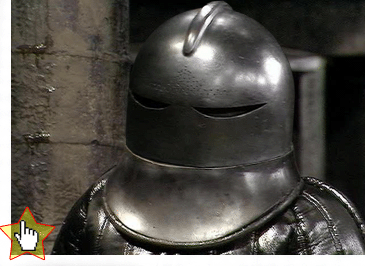 What's interesting is that the Sontarans have been recycled more than any other villain after the Daleks and Cybermen, and despite being loved by fans, never really had the main stream impact to become the third "famous" baddie. They do have some imprint on the public at large, as Billie Piper famously described them as looking like a poo in a spacesuit - which is fair enough really - and Christopher Eccleston rather unconvincingly listed them as one of his childhood favourites when he was interviewed on daytime TV soon after being cast as the ninth Doctor, however he later revealed he had never watched the show as a child.
What's interesting is that the Sontarans have been recycled more than any other villain after the Daleks and Cybermen, and despite being loved by fans, never really had the main stream impact to become the third "famous" baddie. They do have some imprint on the public at large, as Billie Piper famously described them as looking like a poo in a spacesuit - which is fair enough really - and Christopher Eccleston rather unconvincingly listed them as one of his childhood favourites when he was interviewed on daytime TV soon after being cast as the ninth Doctor, however he later revealed he had never watched the show as a child.
Beyond their four canon appearances, they also appeared in a Jim'll Fix It programme in a mini adventure called A Fix with the Sontarans and they also featured in the impressive Dreamwatch/Reeltime fan releases called Shakedown: Return of the Sontarans and Mindgame. They also appear in the spoof video Do You Have A License To Save This Planet?
The Sontarans were created by Robert Holmes in 1972 in a story format which was then quite rare - the pseudo-historical story, whereby a realistic historical setting was intertwined with a futuristic alien presence. Their next story was by Bob Baker and Dave Martin, their third by Graham Williams and Anthony Read before finally Robert Holmes returned to writing for his creations.
The Time Warrior
Cast of | The Time Warrior |
| Doctor Who Sarah Jane Smith The Brigadier Commander Linx Irongron Bloodaxe Edward of Wessex Lady Eleanor Hal the Archer Professor Rubeish Meg Eric Sentry Robot Knight | Jon Pertwee Elisabeth Sladen Nicholas Courtney Kevin Lindsay David Daker John J. Carney Alan Rowe June Brown Jeremy Bulloch Donald Pelmear Sheila Fay Gordon Pitt Steve Brunswick Dudley Long |
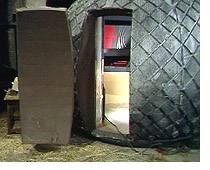 We first meet the Sontarans in the middle ages, somewhere been the year 1189 and 1199. The Sontaran Linx arrives on Earth in his distinctive three-quarter sphere spaceship as a Commander of the Fifth Army Space Fleet of the Sontaran Army Space Corps. He plants his white S-branded flag and claims Earth for his own people.
We first meet the Sontarans in the middle ages, somewhere been the year 1189 and 1199. The Sontaran Linx arrives on Earth in his distinctive three-quarter sphere spaceship as a Commander of the Fifth Army Space Fleet of the Sontaran Army Space Corps. He plants his white S-branded flag and claims Earth for his own people.
The third Doctor only seems to recognise the Sontarans indirectly - he remarks that Linx's attitudes seem Sontaran, but he wasn't sure until Linx identified himself. It is as if the third Doctor had only read about Sontarans but never even seen them, but when Linx asks if the Doctor has met his race before, he does reply "Unfortunately," so the Doctor's other remarks are very out of place. When and where the Doctor first meets a Sontaran only becomes further complicated in the sixth Doctor story The Two Doctors (see below).
Sontaran Technology
Although Linx has access to crude time-travel technology in his ship, it is never suggested that Linx has traveled through time to reach 12th century Earth, hence we discover that the Sontaran race is far more advanced than the human race and has been at war with their sworn enemy the Rutans for millennia. The first piece of their advanced technology we see is a translator which allows Sontaran Linx to speak in English. 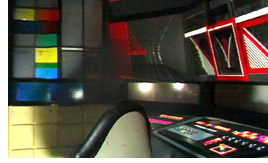 His second useful technological tool is his weapon which can be used as a cutting torch, stun gun and mind control device. Linx also has a chair with skull cap which
His second useful technological tool is his weapon which can be used as a cutting torch, stun gun and mind control device. Linx also has a chair with skull cap which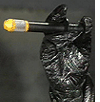 allows him to keep a prisoner at a work place which will deliver an electric shock should he try to escape. The inside of Linx's Sontaran Spaceship is pictured on the right.
allows him to keep a prisoner at a work place which will deliver an electric shock should he try to escape. The inside of Linx's Sontaran Spaceship is pictured on the right.
We learn all the key facts about the Sontaran race during the story. Their bodies are short and powerful, with muscles designed for load bearing on a planet with a very high gravity. If we were to guess Linx might weigh an unlikely maximum of 20 stones then for him to weigh the 'several' tons which the Doctor estimates, then his homeworld must have a gravity of around 20 times that of Earth! Perhaps the Doctor is exaggerating somewhat as a planet of 20G is unlikely to allow the evolution of anything upright like a human, although it might account for an evolutionary path without the luxury of a slender neck! Linx is also disparaging of the human race's two genders, and he suggests that the system be changed.
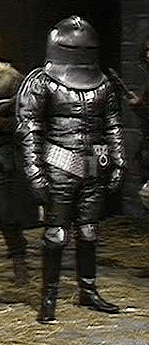 The Sontarans are a militaristic race, reveling in glory and relishing confrontations. Linx is intelligent and although slightly manipulative in his eagerness to get the job done, he is honourable and not needlessly sadistic or murderous. In fact, Linx is one of the least violent villains in Doctor Who history as he arrives quite peacefully, strikes up an alliance with the local humans and ultimately he only kills one person in the whole story, and even that is only when attacked. Naturally he attempts to kill the Doctor a couple of times, but thankfully he doesn't try especially hard.
The Sontarans are a militaristic race, reveling in glory and relishing confrontations. Linx is intelligent and although slightly manipulative in his eagerness to get the job done, he is honourable and not needlessly sadistic or murderous. In fact, Linx is one of the least violent villains in Doctor Who history as he arrives quite peacefully, strikes up an alliance with the local humans and ultimately he only kills one person in the whole story, and even that is only when attacked. Naturally he attempts to kill the Doctor a couple of times, but thankfully he doesn't try especially hard.
Earth is considered strategically significant to the Sontarans and Commander Linx is on a reconnaissance mission in their long conflict with the Rutans.
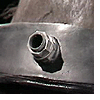 Sontarans are susceptible to an attack on their Probic Vent (pictured right), which is a small tube on the back of their necks. It is not explicitly stated at this stage that Sontarans are clones, however we learn that at their military academy there are hatchings of a million cadets at each muster parade.
Sontarans are susceptible to an attack on their Probic Vent (pictured right), which is a small tube on the back of their necks. It is not explicitly stated at this stage that Sontarans are clones, however we learn that at their military academy there are hatchings of a million cadets at each muster parade.
As mentioned, Linx is not especially evil, and although he doesn't treat his slaves particularly well, his worst crime is damaging the time line by providing Irongron with more sophisticated weapons than the period should have. However there have been numerous instances where human evolution has been spurred on specifically by alien intervention - not least in The Daemons, but also with the meddling of The Monk who amongst other things allowed Stonehenge to be built using an anti-gravity lift. So whereas the Doctor once insisted to Barbara in The Aztecs that the course of history was already set in stone, we are now presented with the idea that history is fluid and any messing about in the past will create a different future. It's an inconsistent rule in Doctor Who because you have the likes of Pyramids of Mars where the Doctor flits forward to 1980 to show the consequences of them abandoning their battle, and on the other hand, there's The Visitation which shows that if aliens hadn't landed on Earth, key events such as the Great Fire of London would never have happened.
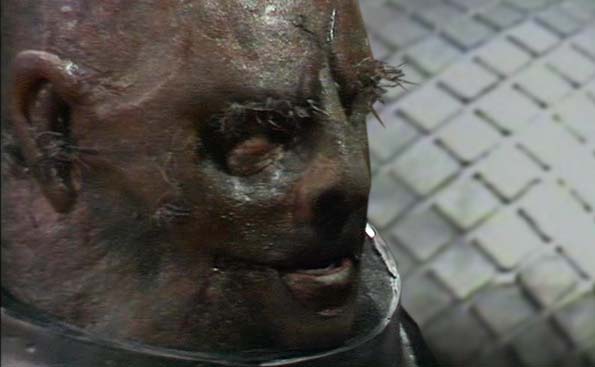
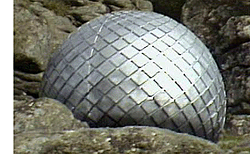 The Sontaran Experiment
The Sontaran ExperimentThe next time the Doctor meets the Sontarans is in the far distant future after solar flares had cleansed the surface of the Earth. In The Sontaran Experiment the Doctor finds his old enemy trying to determine the weaknesses of the human race so that an invasion can be effective.
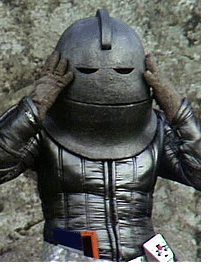 The distinctive small three-quarter sphere ship appears once more but the Sontaran within, this time named Styre, has a number of differences to their previous appearance. It is made all the more odd that Sarah seemed to consider this second alien totally identical to the first one that she met. However Sontaran Styre had much lighter skin, thicker lips on a very broad mouth, a wider nose, and more pronounced forehead and cheek bones. He also had five fingers instead of the distinctive three which Linx had had and is lacking whiskers.
The distinctive small three-quarter sphere ship appears once more but the Sontaran within, this time named Styre, has a number of differences to their previous appearance. It is made all the more odd that Sarah seemed to consider this second alien totally identical to the first one that she met. However Sontaran Styre had much lighter skin, thicker lips on a very broad mouth, a wider nose, and more pronounced forehead and cheek bones. He also had five fingers instead of the distinctive three which Linx had had and is lacking whiskers.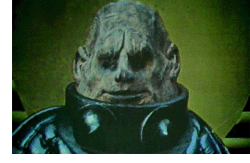 His costume too was slightly different, with the helmet having undergone a slight redesign with narrower but taller eye-slits and a dappled finish, instead of the brushed metal of the previous style.
His costume too was slightly different, with the helmet having undergone a slight redesign with narrower but taller eye-slits and a dappled finish, instead of the brushed metal of the previous style.Field Major Styre is a member of the Sontaran G3 Military Assessment Survey and is answerable to his direct superior The Marshall and ultimately the Grand Strategic Council who rules the Sontaran military system - which could arguably mean they rule the entire Sontaran race.
We learn a little more about the probic vent on the back of the neck as Harry goes into Styre's ship to remove part of the Sontaran's body-recharging system (called a terrulian diode bypass transformer). It is revealed that Sontarans can feed on pure energy. Being a cloned race, we also get to see that Styre's superior, The Marshal, is identical in appearance, except for two large discs which appear on his collar (above right).
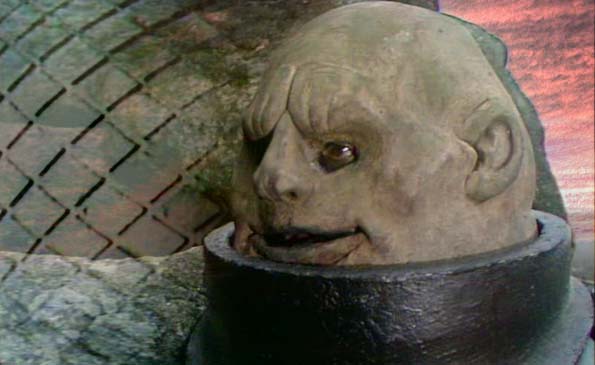
The Invasion of Time
When the Sontarans returned for the season fifteen finale they were taking on the ultimate challenge - invading the homeworld of the Time Lords, Gallifrey. It's an interesting fact that the Doctor's homeworld wasn't named as "Gallifrey" until the first Sontaran encounter in The Time Warrior, and they remain the only alien aside from the Daleks to even consider mounting an assault on the Doctor's native planet.
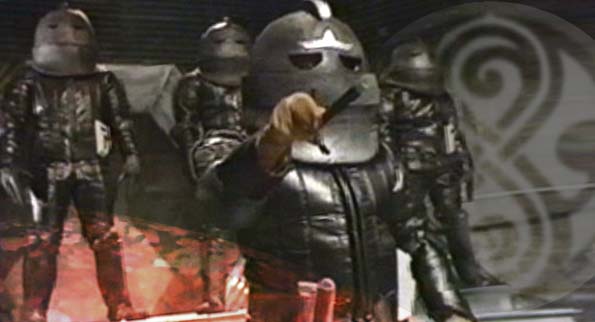
We learn no new information about the Sontarans in their third outing except the size of their army numbers in hundreds of millions and they can clone a million new soldiers every four minutes. In this story we finally see more than one Sontaran on screen at the same time, and they have three fingers on each hand as they did in their debut story. The leader of this group, called Stor, has a helmet which bears a bold version of the insignia first seen on Linx's helmet where it was made up of dots. Stor's helmet has the largest eye-holes so far seen, and bears a very thick rim which differs to his troops.
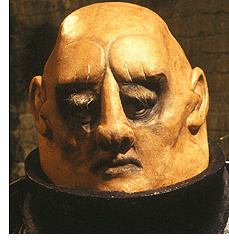
 The probic vent has changed slightly, becoming a larger fixture with a wide slit conveniently just wide enough to accommodate a well-aimed knife from Leela.
The probic vent has changed slightly, becoming a larger fixture with a wide slit conveniently just wide enough to accommodate a well-aimed knife from Leela.The physical form of the sontarans in this story is once again different to their previous appearance, showing that although they may breed by cloning, this does not make them all identical. Perhaps their genetics technology is sophisticated enough for them to make modifications to their bodies for different environments, or perhaps there is a core of ethnically diverse Sontarans back on their homeworld which acts as a template for the rest of the race. In this form, some bristles are present on their eyebrows, but their mouths are narrow like a human's.
Stor who leads the attack on Gallifrey is not the most fear-inducing of aliens. Lumbering, slow-speaking, gullible, possessing a lisp and drifting into an odd cockney accent from time to time, he leads a bunch of the most stupid aliens ever to attempt an invasion, one of whom famously falls over a sun lounger. Not the finest hour of these monsters.
The Two Doctors
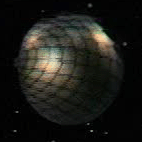 The Sontarans' final appearance in the classic Doctor Who series was in The Two Doctors, a story which featured both Patrick Troughton and Colin Baker. This is an added complication to the fact that Jon Pertwee's third Doctor seemed never to have directly
The Sontarans' final appearance in the classic Doctor Who series was in The Two Doctors, a story which featured both Patrick Troughton and Colin Baker. This is an added complication to the fact that Jon Pertwee's third Doctor seemed never to have directly 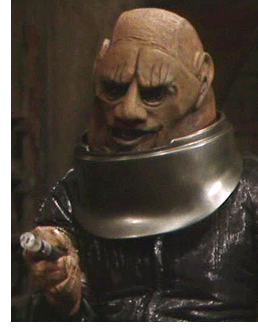 encountered Sontarans before however in The Two Doctors, the second Doctor meets them, and what's more he still recognises them! Therefore we can only assume he has read about them, or encountered them in either his first or second incarnation.
encountered Sontarans before however in The Two Doctors, the second Doctor meets them, and what's more he still recognises them! Therefore we can only assume he has read about them, or encountered them in either his first or second incarnation.Sontaran ships are seen flying in space and unlike earlier stories these ships are fully spherical, rather than having a flat base. Maybe the lower sections can retract into a flat surface for landing?
The Sontarans in this story are represented by Group Marshal Stike of the 9th Sontaran Battle Group and Varl, a somewhat farcical double-act who come across like stuffy colonial British army men, rather than the tough, no-nonsense warrior first seen in Linx. Their heads, although domed, wobble as if there is a normal neck under their loose metal collar. Combined with their tall stature, these are the Sontarans arguably at their most disappointing, and furthest from Robert Holmes' original vision, despite them being back in the hands of their creator.
Their eye-bristles have gone and this time their only hair is on their chin. Their mouths are once again wide as in their second appearance. They carry the normal trademark wand as well as large cumbersome assault rifles.

As well as their "Achilles Heel" of their probic vent, this story also demonstrates that Sontarans are vulnerable to coronic acid, however there can't be many organic creatures who can happily survive a bucket of acid being thrown over them so this isn't really a weakness specific to Sontarans. We discover that Sontarans have green blood.
War with the Rutans
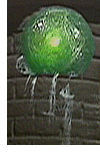 The Sontarans are defined almost entirely by their endless war with a race called the Rutans, also known as the Rutan Host who hail from the planet Ruta III. The conflict has raged for so long that neither side can remember how it started however Linx calls the war a "struggle for freedom" so there is the suggestion that the Rutans started out as oppressors and it spiraled from there, but this could just be Sontaran propaganda.
The Sontarans are defined almost entirely by their endless war with a race called the Rutans, also known as the Rutan Host who hail from the planet Ruta III. The conflict has raged for so long that neither side can remember how it started however Linx calls the war a "struggle for freedom" so there is the suggestion that the Rutans started out as oppressors and it spiraled from there, but this could just be Sontaran propaganda.We know that between the 12th century and the 20th century the solar system went from being an area of little interest in the war, to encompassing the domination of the Rutans which is said to include the whole of our Milky Way, however the Rutans were starting to lose the war. This was the information given in the Rutans' only appearance in the TV show, in Horror of Fang Rock.
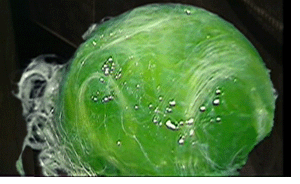 We learn that they are shape-shifting creatures whose natural form resembles a large, green, luminous jellyfish. They are intelligent and although amphibious are capable of considerable movement out of water including the ability to climb walls. They generate a lot of bio-electrical power and, similarly to their warring counterparts, they can feed off pure energy.
We learn that they are shape-shifting creatures whose natural form resembles a large, green, luminous jellyfish. They are intelligent and although amphibious are capable of considerable movement out of water including the ability to climb walls. They generate a lot of bio-electrical power and, similarly to their warring counterparts, they can feed off pure energy.The war with the Rutans showed no sign of abating in the year 13,000 which was the setting of The Sontaran Experiment.
Although Robert Holmes created the notion of the Rutans when he created The Sontarans, it was Terrance Dicks who fleshed out these foes both in Horror of Fang Rock and the spinoff Shakedown. In his own novelisations he added supplementary information about The Great Mother being the repository of the Rutan gestalt intelligence without whom "the Host" i.e. all other Rutans would collapse.
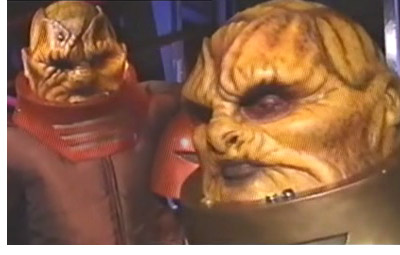 Further Adventures of the Sontarans
Further Adventures of the SontaransThe Sontarans and Rutans appear together for the first time in the Dreamwatch/Reeltime fan video Shakedown: Return of the Sontarans, written by Rutan aficionado Terrance Dicks. Both aliens were used under license of the estate of Robert Holmes who is down as the creator of the Rutans, even though Terrance Dicks was the man responsible for establishing almost everything we know about them.
The Sontarans in Shakedown are led by commander Commander Steg and this time the overhaul in their design was due to copyright reasons.
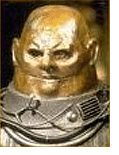 The potato-head creations appear again in a spinoff once again penned by Terrance Dicks, called Mindgame. In this simple set-piece a Sontaran is imprisoned with a Draconian and a human. The Sontaran looks very much like Linx from their debut story, with a lot of extra wiring around his metal collar.
The potato-head creations appear again in a spinoff once again penned by Terrance Dicks, called Mindgame. In this simple set-piece a Sontaran is imprisoned with a Draconian and a human. The Sontaran looks very much like Linx from their debut story, with a lot of extra wiring around his metal collar.The Sontaran Stratagem
These popular aliens return in series four of the new series of Doctor Who with Christopher Ryan (who previously appeared in The Trial of a Timelord) playing their leader General Staal in episode four, The Sontaran Stratagem. His diminutive stature suits these monsters who were originally supposed to be short, unlike their later portrayals.
The new series Sontarans present quite a departure from the previous design but still remaining faithful to their stocky, militaristic concept. Their uniforms have taken on a graphite blue hue with giant shoulder pads and accentuated muscles. They carry gigantic weapons similar to in their final TV apperance The Two Doctors.
Tuesday 17 June 2008
Midnight
Aliens/Enemies: Unknown
New Characters: Sky, Professor Hobbes, Dee Dee Blasco, Biff & Vale Cane, Jethro, Hostess
Gadgets Used: Unknown
Episode Objective: To visit the diamond glacier, and then to survive and escape the knocking on the bus.
Except, he's not alone for long.
There's Sky Silvestry, a businesswoman in her 40's, strong, but quiet.
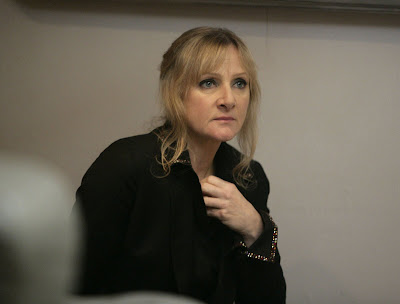 The shambolic Professor Hobbes, full of enthusiasm;
The shambolic Professor Hobbes, full of enthusiasm; His young assistant Dee Dee Blasco;
His young assistant Dee Dee Blasco; Biff and Vale Cane, a nice couple on their holidays;
Biff and Vale Cane, a nice couple on their holidays;

Their 18-year old son Jethro, a bit of a goth, sullen, moping;
 And the Hostess, on duty in the aisle.
And the Hostess, on duty in the aisle. All of them are aboard the Crusader 50 shuttle bus as its sets off for the planets big attraction.
All of them are aboard the Crusader 50 shuttle bus as its sets off for the planets big attraction.This episode is the biggest kept secret of the series! And the less you know before watching it, the more you'll enjoy it.
Its largely a Donna-lite
Its the "low budget" episode.
Features the line "Chicken or beef"
Its the 50th episode to be filmed of New Doctor Who
Donna only appears for the first 2 minutes and last minute. She decides to stay by the pool whilst The Doctor goes on a 4 hour shuttle journey to visit a remarkable sapphire waterfall. But, while Donna is sunbathing and not getting into copious amounts of trouble, bad things are install for the Doctor.
It also highlights, with Donna not around for most of the story, how important his companion is to him. But the most terrifying part is how it explores how human beings respond when they're under intense pressure."
(Lizo's review)
Donna: You be careful
The Doctor: Taking a big space truck with a bunch of strangers across a diamond planet called Midnight... what could possibly go wrong?!
Ooh! Foreboding words there!
But of course the Doctor needs to settle himself in and have a quick chat to the hostess:
HOSTESS: Enjoy your trip.
THE DOCTOR: Oh, I can't wait! Allons-y!
HOSTESS: I'm sorry..?
THE DOCTOR: It's French, for let's go!
HOSTESS: Fascinating.
Apparently we will hear another Allons-y and a Malto Bene at some point in the episode.


And theres the irony kicking in. What could go wrong?
Well... that for a start...
Looks like the shuttle bus is having a bit of difficulty there. So now our little team of tourists are trapped on a tiny bus in the middle of no where.
Well, at least the Doctor keeps his head.
So now what? Stuck on a bus in the middle of nowhere with only a strange man to rely on? No wonder tempers are raised.
Doctor: If we're going to get out of this, then you need me!
Vale: Oh, like you're so special
Hostess: Two people are dead!
Doctor: Don't make it a third!


Apparently theres a point in the episode which only works if the Doctor is alone. The affection between the Doctor and Donna shines in the couple of minutes they are together at the start and end of the episode.
But, moving on from that, the knocking begins. The knock-knock-knocking on the outside of the bus...
Sky: What the hell is making that noise?
Vale: Its trying the door!
Hobbs: There is no "it"!
Sky: What is it? Just tell me what the hell it is?!



So, according to some review or other "Only Sky seems to know the truth – but as paranoia turns into a witch-hunt, Sky turns the Doctor's greatest strengths against him, and a sacrifice must be made..."
And who is this mysterious Sky, who apparently knows something or other? Well apparently whatever it is that is making the knocking manages to possess Sky... and "terrible things are said"

Lesley Sharp, interviewed on "Loose Women" said that at the end of the episode there won't be a lot left of Sky Silvestry
And although we know theres an alien threat, we don't know what it actually is. But we do know that its effecting the Doctor.


Some lucky people have already seen this episode, and the feedback they give, while sparse, is constantly rewarding. They say Tennant is amazing, and someone kindly gave away this info:
- The first 10 minutes has a lot of humour
- In the early part of the episode, The Hostess uses a very funny line when talking to the passengers
- Rafaella Carra (Italian singer) appears "in all her glory" as part of the in-shuttle entertainment package (briefly replaced by Rose)
- "Doctor, Doctor" is briefly mouthed by someone, via a monitor, but the Doctor doesn't see the message (Rose)
- Klicks
- Fear and paranoia reign supreme. Someone must make the ultimate sacrifice. By C=O's recollection, 10 people are aboard the Shuttle when it leaves. By the end only 6 are left.








